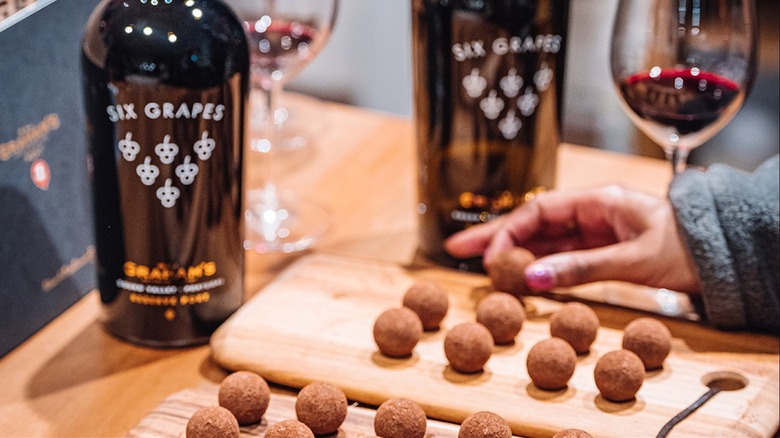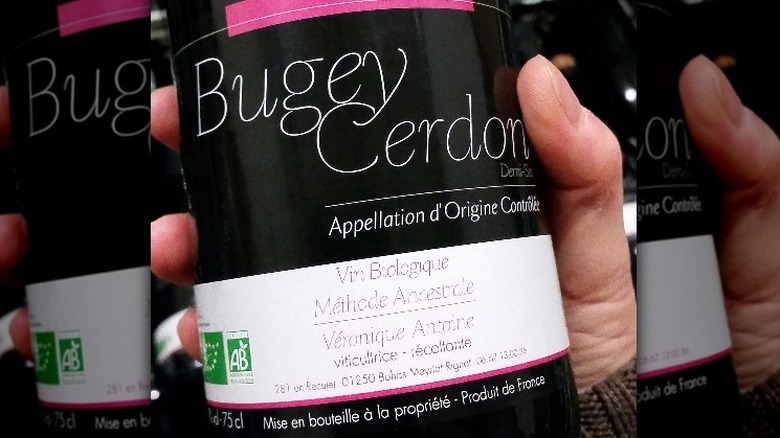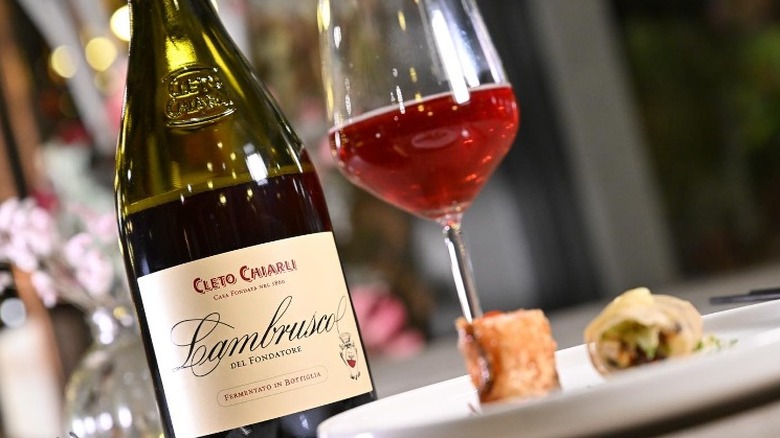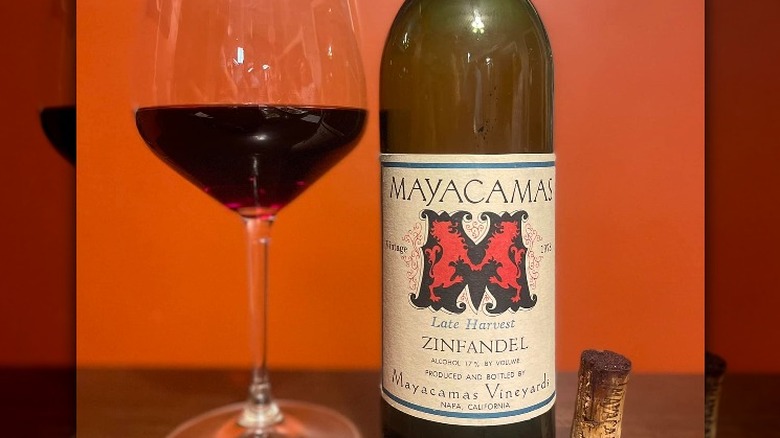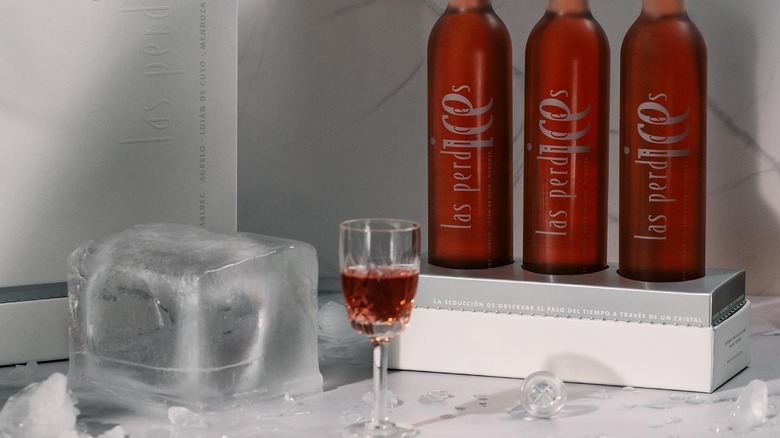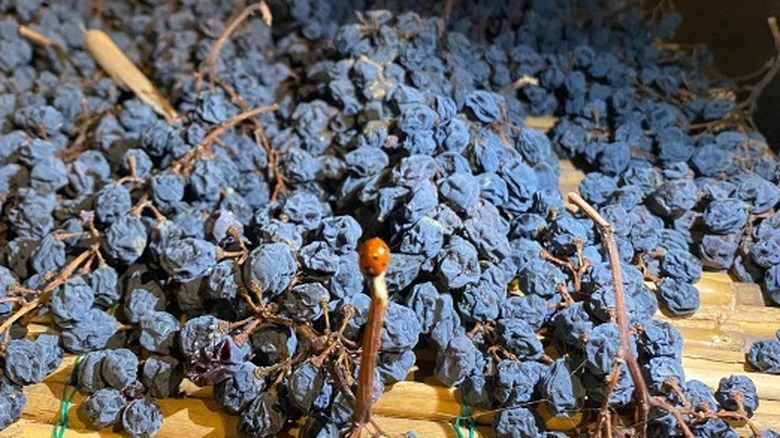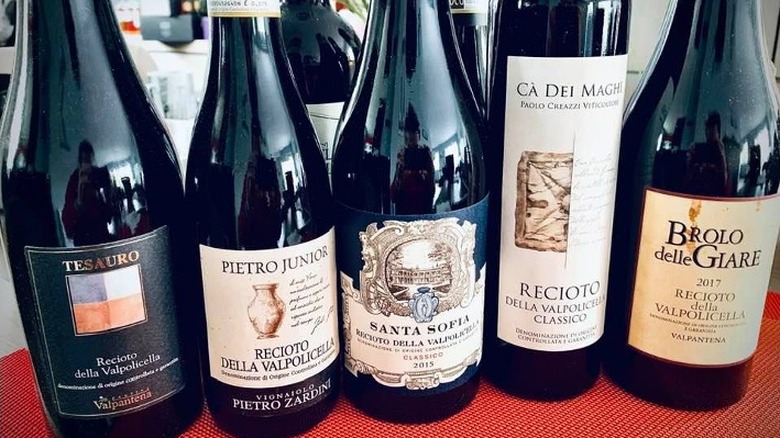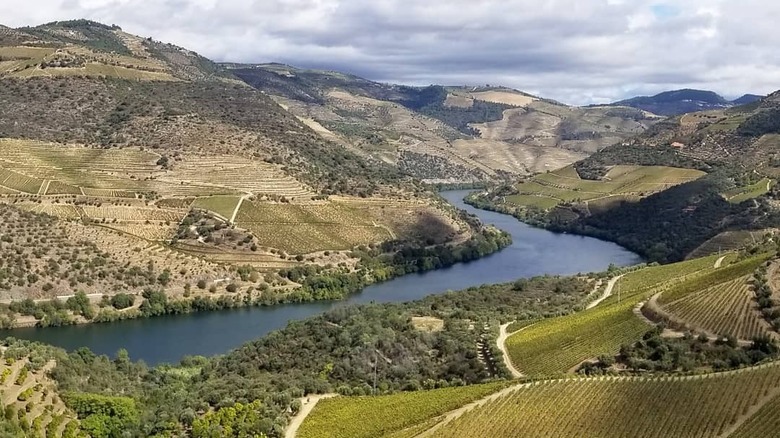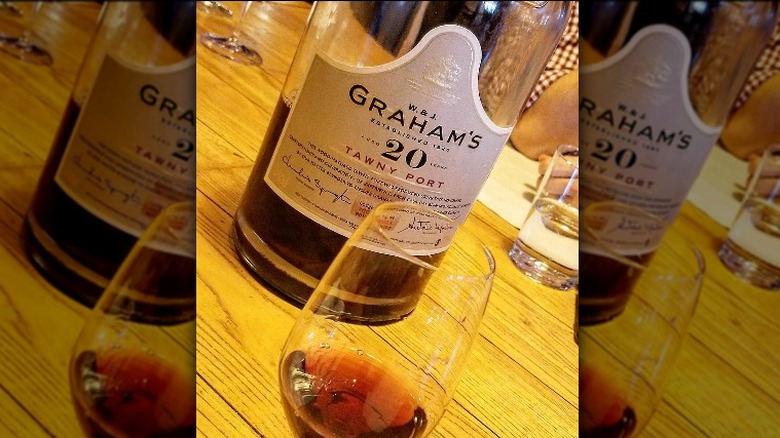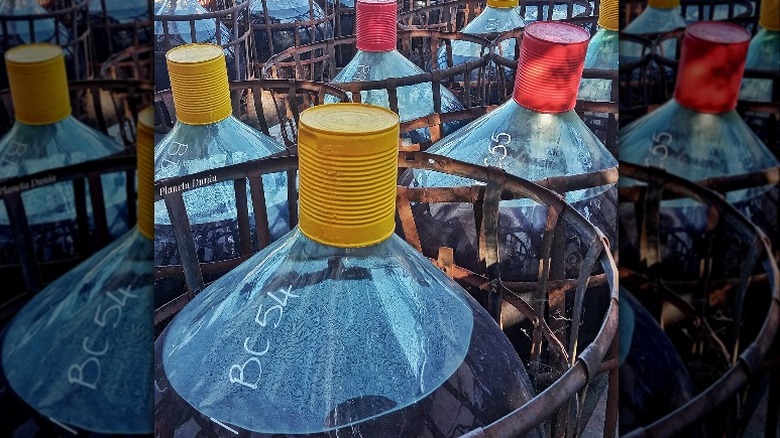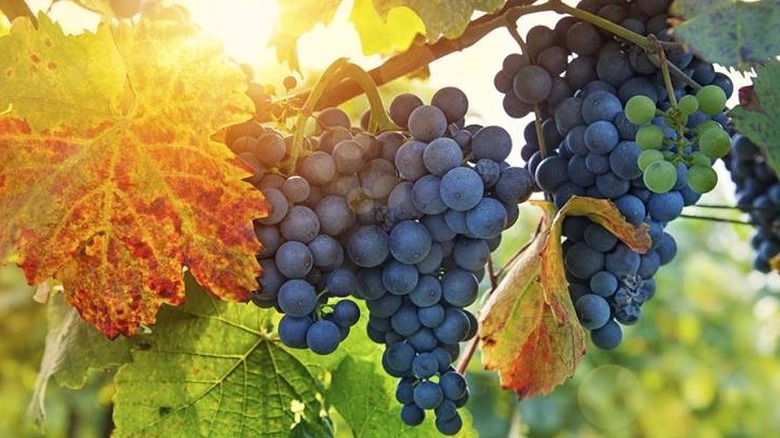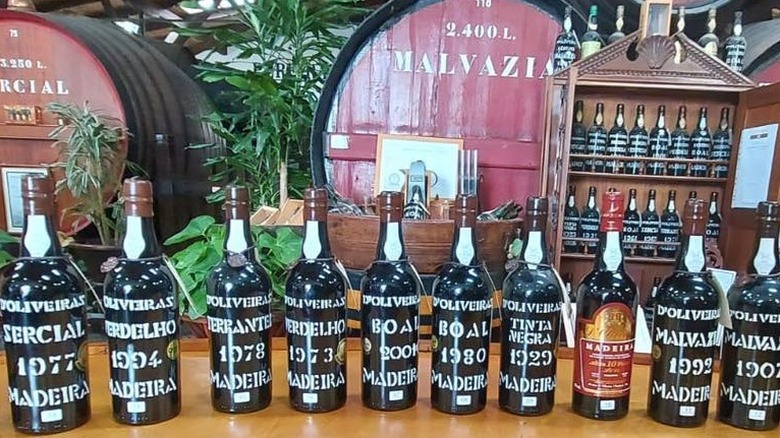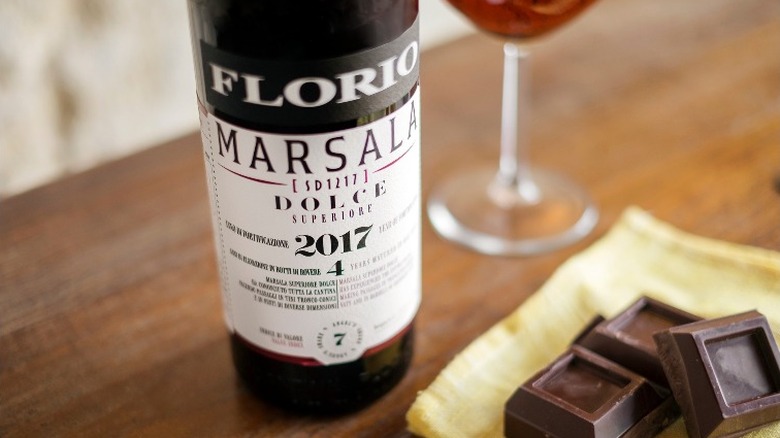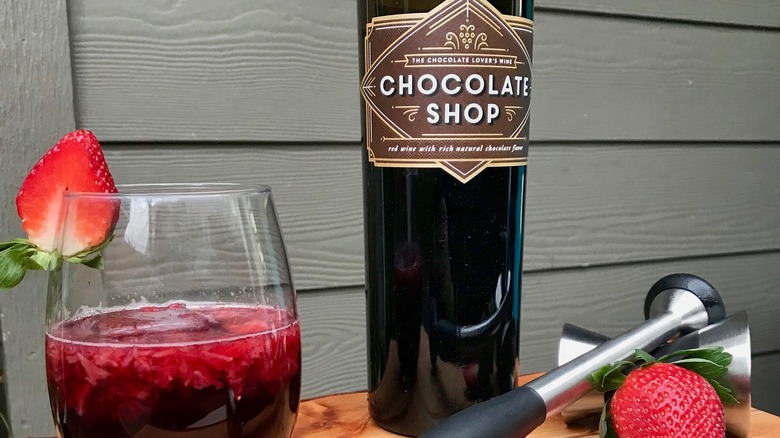14 Types Of Sweet Red Wine
We might say we want a dry wine, but a recent Sonoma State survey concludes that over 38% of Americans prefer sweet wine over dry (via Wine Business). The sweet wine industry in America is valued at over $1 billion, according to Nielsen, which Wine Enthusiast reports accounting for 13% of the total wine sales in the U.S., growing over 40% through the Covid pandemic from previous years. The wine type is likely booming because winemakers focus on crafting high-quality dessert selections that will pair with foods beyond dessert, like spicy Asian, Thai, and Mexican flavors revealing the fruit's natural acidity with the backbone of honeyed sweetness.
But, what technically is a sweet wine? Is it a fruity wine or a wine with residual sugar (as in sugars that have not become alcohol)? Sweet wine typically falls around 30 grams or more of residual sugar per liter, while dry wines typically contain less than 10 grams per liter. The wine industry's terminology classifies dessert wines with high levels of residual sugar as sweet wine selections. Other options within the dry wine category note their sweetness in terms of their fruity character.
Some of the most recognizable sweet wine options are from white grapes, such as noble rot wines Sauternes and Hungarian Tokaji wine, and Pedro Ximénez sherry, but delicious red grape options are also available. Here are the best sweet red wines you should be enjoying right now.
Brachetto d'Acqui
The Italian region of Piedmont is known for producing aromatic white truffles, flavorful hazelnuts, and the king of wines and the wine of kings, Barolo. But, these culinary delights aren't the only items growing in the rolling hills of the Northwestern Italian region. Piedmont is also the home of the sweet, sparkling wine Brachetto d'Acqui.
Italy's Brachetto d'Acqui consortium says the wine is an aphrodisiac with a history dating back to the Romans when Julius Caesar sent the sweet red wine to Egypt in the courtship of Queen Cleopatra. The romantic qualities of the fruit begin with the intoxicating perfumed aromas of fresh roses and wild berries, leading to ripe red fruit and candied apple flavors. The brachetto grape variety is naturally high in sugar content and creates wines with a low level of alcohol.
While non-sparkling options are available, the most common style is sparkling Brachetto d'Acqui, which crafted in the similar Charmat method to the fermentation of prosecco and is made in the region of Acqui within Piedmont. With a zesty effervescence, the wine is best consumed shortly after bottling when the fruity freshness is at its height, paired with chocolate desserts like a decadent chocolate mocha cake.
Bugey-Cerdon
The Bugey-Cerdon sweet wine originates from the sub-appellation of Cerdon in the region of Bugey, located within the Jura Mountains of France and in the shadow of the Alps. A frothy, fun, fizzy red wine emerges from the gamay and poulsard grape varieties. Importer Kermit Lynch describes the wines as light-hearted, cool-climate masterpieces due to the difficulty vintners overcome growing fruit in the region's steep rocky limestone-rich soils. Though the growing conditions for the fruit are challenging, the wines are not.
With bright fuchsia pink, the sparkling wine is classically a méthode ancestrale-style bubbly. Producer Renardat Fache explains this production style forgoes the addition of sugars or yeast during fermentation, instead using only the natural yeast on the fruit to spark the sparkling wine's fermentation. The resulting sweet, fruit-forward wine has lower alcohol content, usually around 8%. Flavors include ripe raspberry, stone fruit, crushed stone, and toasted spice, which is perfect for enjoying as an aperitif with savory bites, like chicken liver mousse, or sweet treats like a French strawberry pie recipe.
Lambrusco
From Italy's Emilia-Romagna region comes a sparkling red wine crafted in sweet or savory styles, sometimes offering a bit of both. Lambrusco is crafted from many Italian grape varieties, all going by the same name. The dry styles show more earthy, forest-floor, and savory balsamic qualities. In contrast, the sweeter types are aromatic, rich, and enticing.
The sweet lambrusco styles traditionally made from the lambrusco salamino grape, which reveal floral notes of fresh roses, violets, and wildflowers that meld with blackberry and black cherry flavors. These wines are also tannic with mouth-watering astringency, which the sugary sweet styles balance to create harmony in the glass.
One of the finest is from the Chiarli family, making high-quality lambrusco in Emilia for over 100 years. Chiarli Modena lambrusco salamino secco is bubbly and fresh with captivating aromas of fresh flowers and wild berries. Lambrusco is perfect for pairing with fruity desserts, as well as a rich game or meat dish like Italian osso buco.
Late-harvest red
Creating a late-harvest wine happens when the fruit remains on the vine for some time after it has reached full maturity, usually, a few months after grapes for producing dry wines have been picked. The extended hang time allows the grapes to raisin, losing their water content while concentrating the sweetness and flavor, and increasing the alcohol level naturally.
Alcohol in the wine is measured by degrees Brix, as in sugar content. During fermentation, winemakers add yeast to pressed grape juice, and the yeast turns the sugar into alcohol. In a typical dry red wine, the grapes will be harvested around 24 Brix to create a wine with around 13 to 15% alcohol. In late-harvest wines, vintners pick the fruit typically at much higher levels creating wines with higher alcohol. However, winemakers halt the fermentation before all of the residual sugar is removed to produce sweet wines.
Any grape can be left for an extended period with zinfandel being a popular red wine option because the fruit naturally displays flavors of blackberry jam, sweet spice, and vanilla. We recommend matching the sweetness of the food you will enjoy with the sweetness of the wine. Sugar in foods can cancel out the fruity flavors of the wine, so make sure the tastes are comparable to produce a perfect pairing for sweet wines.
Ice wine
Some of the sweetest wines in the world allow ripe ready-to-harvest or late-harvest grapes to freeze on the vines. The process occurs towards the end of the growing season when the water inside the grapes is freezing and thawing continuously. As this happens, the sugars and flavors of the grapes concentrate and intensify, producing highly sweet ice wine. White grapes are traditionally the base for ice wine from Canada or Germany; however, select growers worldwide, like in Argentina, also use red grapes to produce unique ice wines.
Las Perdices uses malbec for its Las Perdices Ice made by harvesting the fruit late in the season, when the fruit has begun to dehydrate, therefore, concentrating the flavors, and then manually freezing the grape bunches to achieve a similar effect of natural ice wine. When the fruit is frozen, the ice crystals are pressed out of the must, leaving the syrupy, highly-flavorful juice behind. This juice then undergoes fermentation, resulting in intensely rich flavors of ripe morello cherry, black plum, and quince. The typical ice wine lingers on the palate with a silky finish.
Vin santo
Vin Santo is Italy's celebrated sweet wine made in the passito style by drying ripe grapes on mats that allow the grapes to raisin and strengthen the flavors. The process takes several months with the fruit losing over half its weight when it is time to press the fruit, according to Forbes, meaning it takes almost 22 pounds of grapes to produce one liter of vin santo. White grapes are often the base for the dessert wine, such as trebbiano and malvasia grapes for Tuscan vino santo options.
Tuscany's red versions are commonly made with sangiovese and malvasia nera. The Italian Wine Guide explains vin santo occhio di pernice, or eye of the partridge, blends both red varieties to create a concentrated wine that must age for a minimum of three years before release. The aging time further intensifies the honeyed, dried fig, and caramelized toffee flavors in the wine, making it perfect for enjoying with its traditional accompaniment, Italian biscotti.
Recioto della Valpolicella
Crafted in style similar to vin santo, the Italian dessert wine recito della valpolicella is made from harvested red grapes that are left to dry for months on straw mats until the fruit raisins to concentrate the flavor. By law, the fruit is required to dry until at least the first day of December after harvest, a production style known as the appassimento method; however, it often takes several more months.
The production of amarone wine also uses this winemaking style; however, amarone is a dry wine, while recito is incredibly sweet. The wine site shares that the finished Recito wine often has over 50 grams of residual sugar per liter. Wine Spectator adds the creation of Amarone likely happened because a winemaker allowed fruit intended for Recito to ferment to become a fully dry wine.
The flavor of Recito is what makes it so unique and delicious. A blend of grapes like corvina, molinara, and rondinella create the dessert wine, enhancing the silky and sweet flavors of dried fig, prune, dried cherry, and blackberry, which meld with vanilla, toasted clove, and nutmeg.
Ruby port
Wine grapes have long been grown along steeply terraced vineyards in Portugal's Douro Valley along the Douro River. Port producer, Taylor Fladgate, says the history of the dessert wine began with a treaty signed in 1386 that established an English presence in Portugal with equal trade rights between the countries. For hundreds of years the English sent Portuguese wine to their home country in ships across the Atlantic. To prevent spoilage during the long journey, merchants would add a bit of brandy to the wine, a process that was the precursor to what we know today as fortified port wine.
Today, a field blend of native varieties, like touriga nacional, tinta roriz, and touriga franca, are the base for port wine. Wine Folly explains vintners hand harvest the grapes from hillside vineyards, and after harvest, traditional foot-treading in large cement troughs, known as lagares, presses the grapes and allows the juice to have maximum contact with the grape skins and must.
After fermentation and fortification, the wine ages in large casks that are traditionally used for the production of ruby port or in small barrels called pipas for the production of tawny. With 18% to 21% alcohol content, ruby port ages a minimum of three years in large casks where the juice has little contact with the barrel, followed by aging for extended periods in the bottle which enhance the wine's fruity qualities, showing layers of dried blackberry, black cherry, and dark chocolate.
Tawny port
The production of a ruby and tawny port begins the same. The significant difference between the two styles is that tawny port has contact with the barrel as a defining characteristic of the wine. Tawny production uses small barrels that are continually racked, a process where the wine moves from one vessel to another. The racking of the wine encourages oxidation and contact with the oak. The wine is also constantly tasted and blended with other vintages to achieve a harmonious balance between the fruit, the influence of the barrel, and sweetness and alcohol.
There are five primary styles of aged tawny port, including reserve, colheita, 10, 20, 30, and 40-year-old. Understanding the influence of the oak for that extended period takes impressive skill and craftsmanship, similar to aging scotch or other whiskies. A 10-year-old tawny will have more acidity and freshness with a subtle presence of oak. A well-aged 30 or 40-year-old tawny delivers nutty and highly-caramelized flavors of toffee, dried orange peel, dried fig, and roasted hazelnut.
Banyuls traditionnel
Winemakers create the dessert wine Banyuls in the Roussillon region of France, located in the southwest near Spain. The Wine Guy says grapes have been grown in the region for centuries, along with the process of fortifying, called mutage, which was first discovered in 1285 when a professor at the University of Montpellier added a grain spirit to fermenting grape juice that halted the fermentation.
The creation of banyuls traditionnel uses predominantly grenache fruit that grows on terraced vineyards and raisin on the vine before harvest. After pressing, Wine Enthusiast reports the juice is fermented to 5-10% alcohol and then fortified to around 16%. After mutage, the wine ages in sealed casks to avoid oxidation. More traditionally, the wine is placed in large glass containers called demijohns in the sun to bake and oxidize for 30 months. This lengthy aging oxides the wine to create nutty, caramelized flavors that meld with sweet chocolate, dried herbs, stewed prunes, and baked cherries. The result is a complex, multidimensional, and hedonistic wine.
Alpenz notes that due to the quality and craftsmanship of the dessert wine, the wine region was one of the first in France to receive an appellation status in 1936. Though classically paired with chocolate or red fruit desserts, the wine is delicious with fresh, tangy goat cheese, teriyaki, or Asian dishes with sweet and sour sauce.
Mavrodaphne of Pátras
From sun-drenched vineyards near Pátras in the Peloponnese region of Greece, a dessert wine named Mavrodaphne of Pátras comes from the red mavrodaphne grape. The inky, blackish-brown wine is produced similarly to port and sherry. Wine Enthusiast says it's made by adding a neutral grain spirit distilled from older wine vintages to the sweet wine, which stops the fermentation before all of the sugar turns into alcohol. The wine site shares that aging and blending of the sweet wine occurs in a similar solera system utilized in the production of sherry, with the final product including wine from the current release year and many vintages revealing a consistent flavor profile year after year.
Because the grape adapts well to oak aging, the wine matures for several years in casks after fortification, lending caramel, toasted spice, and dark chocolate notes to the fried fruit flavors of dried blueberry, black plum, and cherry.
Madeira
The Portuguese island of Madeira historically acted as a stopover island for sailors on their way to the New World. According to Wine Folly, in the 1600s and 1700s, ships would load their vessels with wine and, throughout the journey, would notice the wine changing and improving as it was heated and cooled throughout the ocean voyage. This heating and cooling technique has become a trademark for the production of Madeira wine. The fortified wine is heated and cooled dozens of times through either the estufagem (or estufa) or cantiero methods to create an oxidized, nutty, caramelized flavor. Because the wine has been cooked prior to bottling, Madeira can age for decades in the bottle and remain unchanged.
The cantiero process is for the highest-quality and most expensive styles by heating the wine naturally in the sun. Wine Folly explains that the youngest, most common, and least expensive style of Madiera wine uses red grapes, called tinta negra, and the estufa method to produce "rainwater" labels. After fortification, the site says that the estufa process ages the fortified wine for three months in heated tanks.
Madeira Wine and Dine reports the tinta negra grape variety accounts for over 90% of the total grapes used in the production of Madeira. The estufa technique combined with the natural black fruit flavors of the fruit creates a candied note of dried cherry and currant with roasted hazelnut.
Marsala
From the western edge of the island of Sicily, Marsala is a fortified wine produced from white and red varieties in dry and sweet styles. Red Marsala, known as rubino, features Perricone, Nero d'Avola, and Nerello Mascalese varieties (via the Italian Wine Guide). Vinepair adds that the coastal location on the edge of the Mediterranean Sea adds a heavy maritime influence and slightly salty character to the wines from the region, which are fortified with a neutral grain spirit that is often made from the native grillo grape, increasing the alcohol level to around 20%.
Rubino is the fruitiest Marsala wine, with a minimum aging of one year within a traditional solera system. The wine blends older vintages with newer ones to create a balanced, consistent flavor profile. The fruity wine has freshness and a bit of tannin, lending complexity and giving structure to the Marsala, layering red berry, ripe plum, toasted nutmeg, and allspice with a subtle hint of salty salinity. The salinity gives it the perfect sweet and salty balance, making it ideal to pair with dark chocolate.
Chocolate wine
Winemakers have hit a home run for chocolate-and-wine lovers thanks to chocolate wine. The Seattle Times reports the drink has been around for decades, and with an average alcohol level of around 12.5%, chocolate wine has one of the lowest alcohol by volume for dessert wines. The wine is produced by adding chocolate (and likely other fruit extracts) to wine. It was initially considered a novelty, but the number of options within the category is growing. Producers are opting to either make a cream version using brandy with a similar taste and texture to chocolate milk or the more exciting options using wine.
One of the best examples is The Chocolate Shop chocolate wine. Its winemaking process includes a blend of ripe red wine with red berry and ripe Bing cherry flavors, as well as oak, which lends sweet baking spice and toasted vanilla notes. The final addition is a chocolate extract, which, understandably, adds the essence of chocolate. Add it instead of port in our chocolate martini recipe or a few splashes into a shortcut mole sauce recipe.
